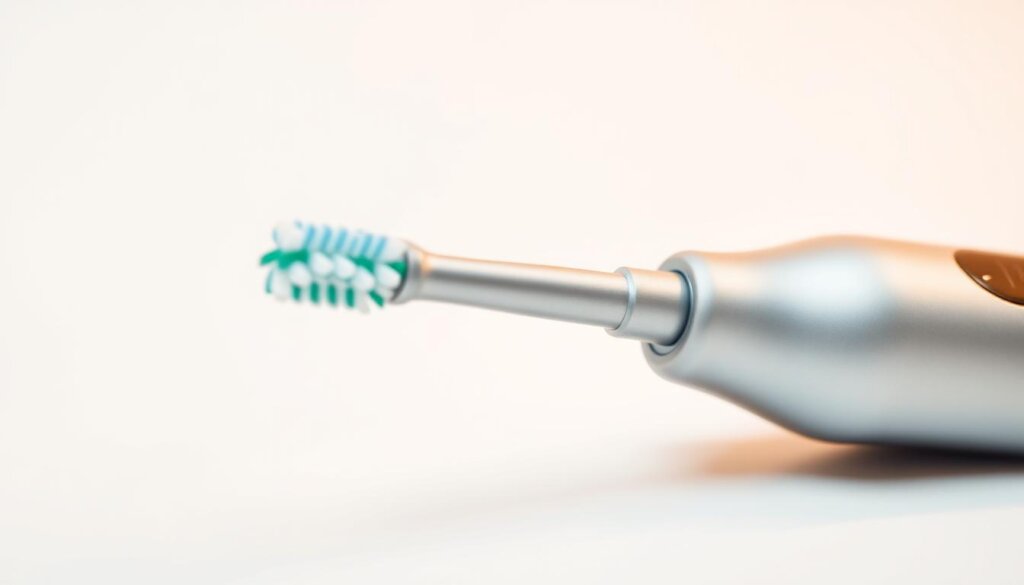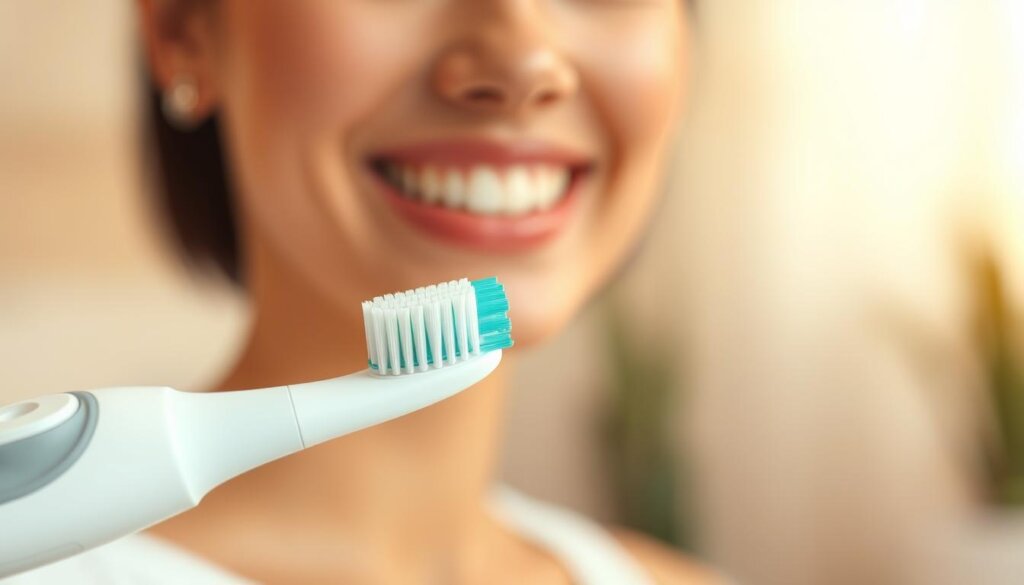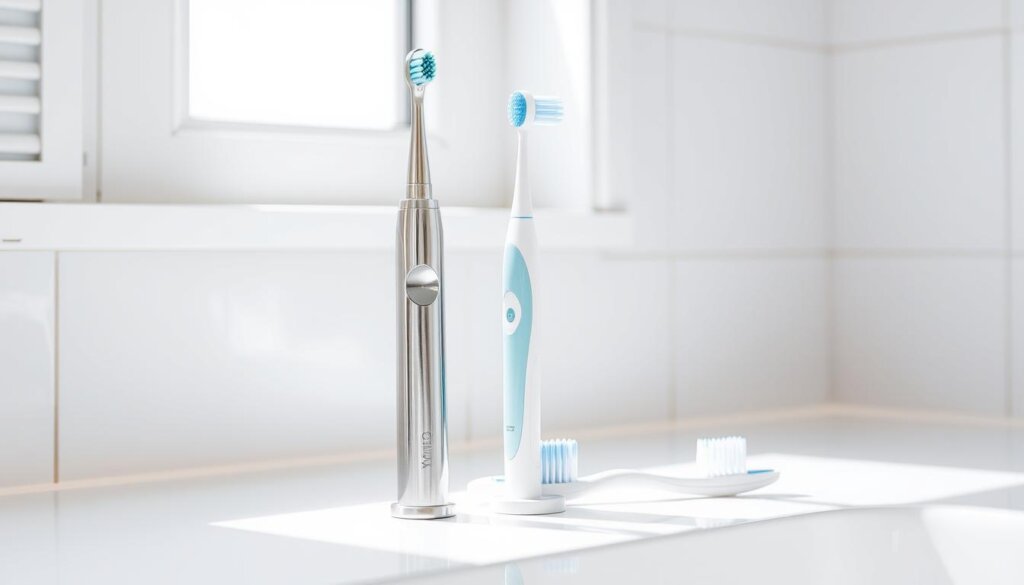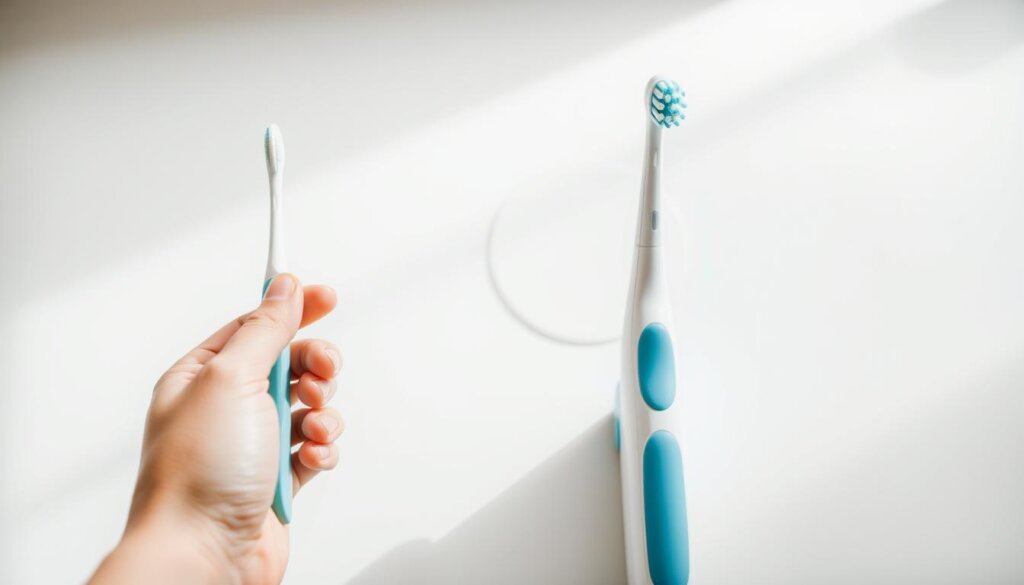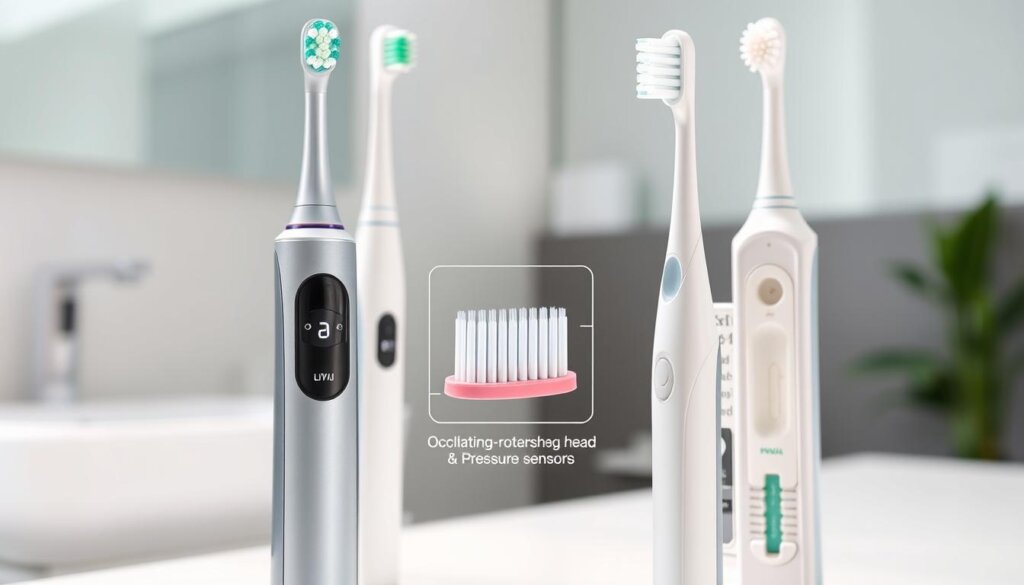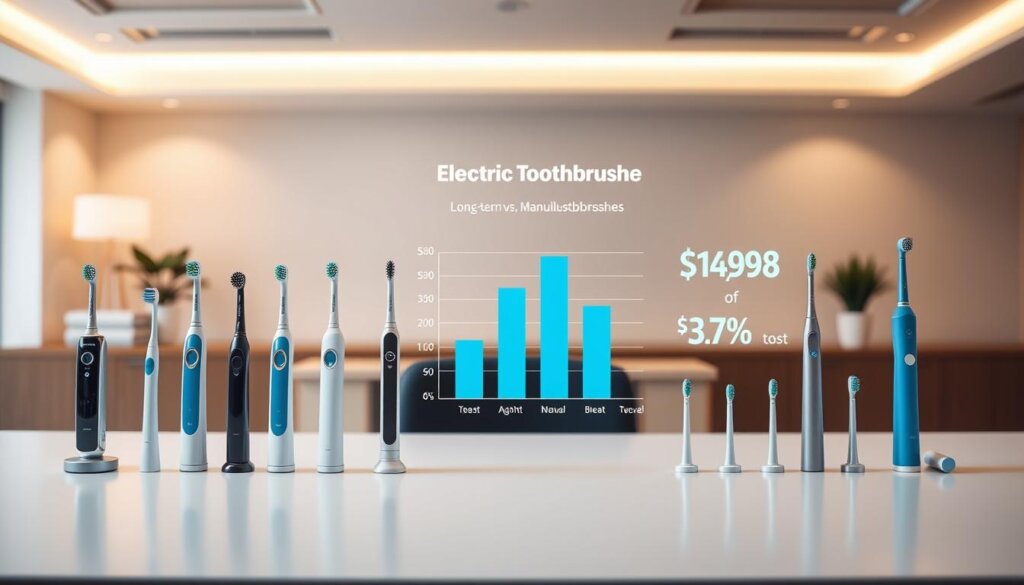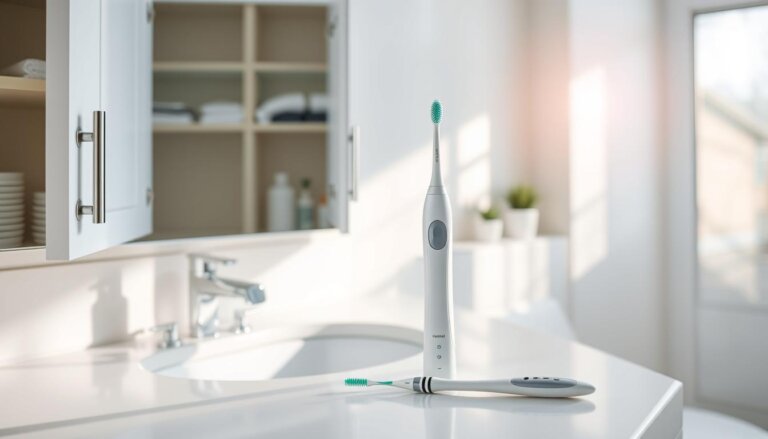Is an Electric Toothbrush Better for Keeping My Teeth Clean?
Can an electric toothbrush keep my teeth cleaner, or does good use of a manual brush do just as well?
People often want a straight answer, but it’s not that simple. According to the American Dental Association (ADA), both kinds can clean plaque if used right. Both can get the ADA Seal of Approval too. Yet, studies generally find electric toothbrushes slightly better, particularly if you sometimes skip your dental care routine.
Research has found that electric toothbrushes with moving heads, like those from Oral-B, do better than just vibrating ones. Sonic brushes from Philips Sonicare also have proven advantages, such as less gum disease and a lower chance of losing teeth over time. Features like timers and pressure sensors make good care habits more regular. This is key in choosing the right toothbrush.
We aim to look at the facts, share what dentists like William E. Graves, DMD, and Dmitry Nikitayev, DDS, see in practice, and guide your choice based on method, comfort, and results. By the end, you’ll know when to use a manual brush and when an electric one might clean better.
Key Takeaways
- Both manual and electric brushes can clean well when used with proper technique and timing.
- Electric brushes, especially oscillating-rotating models, show greater plaque and gingivitis reduction in reviews.
- Timers and pressure sensors improve consistency and protect gums from overbrushing.
- Electric options may help users with braces, limited dexterity, or poor adherence.
- Long-term data link sonic and electric use with better periodontal outcomes.
- Choosing the right tool depends on technique, comfort, and daily routine.
Understanding Electric Toothbrushes
Electric brushes bring new tech to daily care, improving accuracy. They help everyone use the same good technique and make keeping teeth healthy simpler.
Why does this matter? When these devices control speed and force, you just have to worry about brushing everywhere. This blend of help and personal effort leads to better brushing habits that doctors also recommend.
What Is an Electric Toothbrush?
An electric toothbrush uses a motor for automatic brushing. It’s a part of dental tools but stands out because it moves on its own to fight plaque.
Most have timers to ensure you brush long enough. They also have features to make sure you don’t press too hard, keeping your teeth and gums safe.
How Do Electric Toothbrushes Work?
These brushes work by creating tiny movements. These actions remove plaque more efficiently than hand brushing. They reach better around teeth and gums.
Brands like Oral-B and Philips Sonicare break brushing into 30-second parts. This makes sure you brush evenly without too much pressure.
- Automated bristle motion: vibration, oscillation, or rotation
- Feedback features: pressure sensing and pacing cues
- Routine support: timers that promote thorough coverage
Types of Electric Toothbrushes
Today’s dental tools fall into two main groups. Each uses special tech to fight plaque while being gentle on teeth.
- Oscillating-rotating: A small, round head moves in circles to clean each tooth fully. Oral-B is known for this method, offering detailed cleaning.
- Sonic: A thin head vibrates fast to move cleaning fluids. Philips Sonicare is a leader here, with adjustable settings for comfort.
Variants include designs for braces, soft bristles for sensitive mouths, and kids’ models that make brushing fun. These tools all use advanced tech to maintain daily dental health.
The Benefits of Electric Toothbrushes
Modern toothbrush technology matches how we brush our teeth daily. This means cleaner teeth with less work, perfect for anyone’s busy schedule. It helps those at risk for gum disease and dental professionals looking for reliable home care benefits.
Improved Plaque Removal
Studies show big improvements in fighting plaque and healthier gums in just three months. Oral-B’s rotating heads beat vibration-only types by cleaning better around gums and teeth. Philips Sonicare uses sonic waves for long-term health, showing fewer gum disease signs, proving their worth in everyday routines.
- Clinical edge: High-frequency motions reach where regular brushing can’t.
- Everyday impact: Makes cleaning around braces and dental work easier, helping keep mouths healthy.
Consistent Brushing Techniques
Electric toothbrushes offer a consistent cleaning speed, something hard to achieve manually. They’re great for everyone, including those with hand mobility issues like arthritis. They ensure even cleaning and the right amount of pressure, key benefits from using them regularly.
- Less variation in brushing technique boosts effectiveness for all users.
- Kids enjoy brushing more thanks to fun vibrations, leading to better dental health.
Built-in Timers and Pressure Sensors
Timers ensure you brush your entire mouth evenly. Pressure sensors, found in Oral-B iO and Philips Sonicare models, prevent brushing too hard to avoid damaging teeth and gums. These features make sure brushing is both thorough and safe every time.
- Timers make sure every part of your mouth gets cleaned well.
- Sensors help avoid brushing too hard, keeping your mouth healthy in the long run.
Combined, these features of electric toothbrushes mix smart design with proven results. This helps everyone achieve a clean and healthy smile effortlessly.
Comparing Electric and Manual Toothbrushes
People often wonder which toothbrush works best, electric or manual. They are both key for oral health but are quite different. This guide looks at the pros and cons to help decide which toothbrush is more effective.
Effectiveness: A Side-by-Side Look
The American Dental Association says both electric and manual toothbrushes can remove plaque. This is if you brush correctly for two minutes. Some electric brushes are better at reducing plaque and gingivitis than manual ones.
Yet, results can be the same for some older adults, showing it might depend on how you use them. So, using electric brushes could help those struggling with the right technique.
But, if you’re good at brushing, manual can be just as effective. This shows the importance of how we brush.
User Experiences and Preferences
What feels good can influence what we use daily. Some like the vibration of a Philips Sonicare, while some prefer Oral-B’s oscillation. People who travel consider the size of chargers and how easy it is to bring along.
Brush head softness and the handle’s feel are also key. They can make a big difference in sticking to brushing habits. This, in turn, affects how well the toothbrush works over time.
Price Considerations and Value
Electric toothbrushes have a wide price range, from cheap to expensive. Starter ones might cost $15–$50, and fancier ones up to $250. Remember, you’ll need to buy replacement heads too. Manual toothbrushes are cheaper, usually $1–$3.
Choosing between them means thinking about cost versus benefits. Consider how often you’ll replace parts, if it needs batteries or charging, and if it helps control plaque better. Sometimes, a simple manual brush is best, especially with the right technique. Other times, the extra features of an electric brush are worth the cost.
Brushing Techniques: Manual vs. Electric
The price isn’t what makes a toothbrush effective; it’s how you use it. Both manual and electric toothbrushes can keep your mouth healthy if used correctly. The trick is to brush gently, cover all areas, and time it right to protect your teeth and gums.
Why does this matter? Even with advanced toothbrushes, good habits are key. A slight change in how you brush can make a big difference in fighting plaque.
How to Brush Properly with a Manual Toothbrush
Pick a soft-bristled brush that fits your mouth well. Hold it at a 45-degree angle to your gums, and brush gently. Make sure to clean the outside, inside, and top of your teeth.
- Brush twice a day for two minutes. A timer can help you brush long enough.
- Using fluoride toothpaste will strengthen your teeth and help prevent cavities.
- Consider brushes with angled or multi-level bristles to better reach all areas.
After brushing, rinse your toothbrush and let it dry standing up. Replace it every three to four months, or sooner if it looks worn. Don’t forget to floss daily and using mouthwash is up to you.
Best Practices for Using an Electric Toothbrush
Allow the electric brush to do its job. Move it slowly over each tooth and keep the pressure light. Many electric brushes have features like pressure sensors and timers to help you brush just right.
- Position the brush head at the gumline and angle it to clean every tooth surface well.
- Use the timer and pacing features to ensure even coverage of your mouth.
- Always use fluoride toothpaste, and clean and dry your brush after use. Change the brush head every few months.
When choosing a toothbrush, the most important thing is your brushing technique and making sure you brush everywhere. Technology in toothbrushes, from brands like Philips Sonicare and Oral-B, helps with consistency. But daily brushing habits are most important for oral health.
| Aspect | Manual Technique | Electric Technique | Why It Affects Toothbrush Effectiveness |
|---|---|---|---|
| Angle & Contact | 45° to gumline; short, gentle strokes | Hold at gumline; let the head oscillate/sonicate | Optimizes plaque disruption at the sulcus without abrasion |
| Pressure Control | Self-regulated; use light pressure | Pressure sensors help prevent overbrushing | Protects enamel and gingiva while maintaining cleaning power |
| Timing & Coverage | Use an external timer to reach two minutes | Built-in two-minute timer and 30-second quadrants | Ensures complete surface coverage and consistent dwell time |
| Bristle/Head Design | Soft, multi-level or angled bristles | Interchangeable heads tailored to needs | Improves access to interproximal and posterior areas |
| Adjunct Habits | Fluoride paste, floss, replace at 3–4 months | Fluoride paste, floss, replace head at 3–4 months | Supports biofilm control and durability of results |
The Role of Features in Effectiveness
Smart design decides how well dental care tools work every day. When features control speed and pressure, brushing becomes more thorough and gentle. This helps keep teeth healthy without confusion. In comparing toothbrushes, such controls are as important as the motor’s strength or the type of bristles.
How do built-in tools improve toothbrush technology while keeping routines easy? Timers and pace setters ensure users brush for two minutes and reach all areas equally. Pressure sensors warn if you’re brushing too hard, preventing damage to gums and enamel. These features help everyone brush more consistently.
Different Modes and Their Benefits
Mode settings change power and motion to suit various dental needs. For fragile gums, sensitive or gum care modes with soft bristles work best. Whitening or deep clean modes up the power for removing stains and plaque, but only if used right.
- Sensitive: Slow speed for sore gums or after dental work.
- Gum Care: Gentle pulses help break down plaque.
- Whitening: Faster vibrations to tackle surface stains.
- Daily Clean: An all-around setting for everyday brushing.
Top brands like Philips Sonicare and Oral-B have these options, making brushes more versatile. Though not required, many users say these features make brushing easier and more effective.
Battery Life and Charging Convenience
How a toothbrush is powered matters. Long-lasting batteries mean less worry about charging and ensures the brush is always ready. Charging stands and USB-C travel cases, from Philips or Oral-B, add convenience.
Traveling brings its own challenges. Different outlets and voltages can make charging hard. Some travel-friendly brushes use disposable batteries for ease. Being able to get new heads and reliable charging matters a lot to travelers. They might even keep a manual brush or a compact electric one as a backup.
| Feature | Clinical Relevance | User Impact | Example Implementation |
|---|---|---|---|
| Timer & Quadrant Pacer | Promotes complete coverage and even timing | Avoids missed spots; aids routine building | Two-minute timer with 30-second alerts |
| Pressure Sensor | Prevents too much force on teeth and gums | Immediate feedback; softer brushing | Indicator or vibration when too firm |
| Cleaning Modes | Adjusts for different gum sensitivities | Better comfort and custom fit | Sensitive, Gum Care, Whitening, Daily Clean |
| Battery & Charging | Keeps toothbrush ready to use | Less waiting, easier on trips | Long battery life, easy-to-use case, charging dock |
Choosing the right features for your lifestyle and dental needs helps match daily habits with health goals. When you compare toothbrushes, these aspects can mean the difference between okay and great oral health habits.
Studies on Toothbrush Efficacy
Many studies have tested toothbrushes to see how well they work. They look at how toothbrushes remove plaque now and how they help gums in the long run. This is key to keeping mouths healthy for many kinds of people.
Review of Key Research Findings
Research shows that after three months, electric toothbrushes with moving heads are better at removing plaque than those that just vibrate. A study that lasted many years found that people using sonic toothbrushes kept more of their teeth and had healthier gums than those using manual ones.
But not everyone benefits the same way. In older people, the difference between electric and manual toothbrushes in removing plaque wasn’t big. This suggests picking a toothbrush depends on the person’s ability to use it and their gum health.
- Short-term metrics: Plaque and gum disease scores improve more with toothbrushes that rotate and oscillate.
- Long-term metrics: Sonic toothbrush users had less gum disease and kept more teeth.
- Population effects: The benefit was smaller for older adults, showing the need to consider personal needs when choosing a toothbrush.
What Dentists Recommend
Doctors say the way you brush and getting to all areas matters most. Dr. William E. Graves says electric toothbrushes are good for those who don’t brush well. They match what studies find about managing plaque and keeping gums healthy. Dr. Dmitry Nikitayev believes toothbrushes that spin can clean hard-to-reach spots and prevent cavities.
The American Dental Association says both manual and electric brushes can work well if used right. Doctors think about how easy a brush is to use, if someone brushes long enough, and if they’re gentle. Then, they pick the best toothbrush for a person’s needs and habits.
Cost Analysis of Electric Toothbrushes
In comparing toothbrushes, both price and performance shape our decisions. The big question often is: Does an electric toothbrush keep my teeth cleaner? Understanding the costs can help answer this while keeping our main goal of oral health in focus.
Initial Investment vs. Long-term Savings
Electric toothbrushes start around $15 and can go up to $250. Replacement heads cost between $10 and $45 for a pack. On the other hand, disposable electric brushes are cheaper upfront, costing $5 to $8, but you also need to buy batteries. Manual toothbrushes are the cheapest, at $1 to $3, but you have to replace them every three to four months. This shows that while electric options might be more expensive at first, the ongoing costs can be lower than getting new manual brushes all the time.
Using electric brushes has long-term benefits for your wallet, too. Studies have shown they’re better at controlling plaque and fighting gingivitis. This could mean fewer dental visits for users who might struggle with manual brushing. Also, having replacement heads on hand can save on last-minute buys and delivery fees.
Considering the environment is important as well. Electric toothbrush heads create less plastic waste than throwing away full manual brushes. But, using chargers or batteries does increase energy use, which some people think about when planning their dental care.
Are They Worth the Price?
The value of electric toothbrushes varies by person. For example, some older adults might not notice a big difference in plaque removal compared to using a manual brush properly. But for many, features like timers and pressure control can make a big difference in brushing effectively, justifying the cost.
When picking a toothbrush, people also consider brands and how easy it is to get replacement heads. Being able to buy replacement heads easily or finding them on sale can make high-end models more appealing. In any comparison, choosing the right toothbrush means balancing cost, access, and the real benefits you get from using it daily.
| Option | Upfront Cost (USD) | Ongoing Cost (USD) | Replacement Interval | Key Benefits | Considerations |
|---|---|---|---|---|---|
| Electric Handle (Oral-B, Philips Sonicare) | $15–$250 | $10–$45 per multipack of heads | Heads every 3–4 months | Improved plaque control; timers; pressure feedback | Charging or batteries; head availability affects convenience |
| Disposable Powered Brush | $5–$8 | Batteries as needed | Replace device every 3–4 months | Low entry price; powered assistance | Less durable; battery waste; fewer features |
| Manual Brush | $1–$3 | $1–$3 per full replacement | Replace every 3–4 months | Lowest cost; no charging needed | Technique dependent; no timers or sensors |
| Accessories (Floss, Irrigators) | $30–$100 for irrigator; $3–$8 floss | $10–$30 for tips; ongoing floss | Tips every 3–6 months | Complements brushing; interdental reach | Extra counter space; additional routines |
Bottom line for readers focused on keeping their teeth clean: Match the cost of the toothbrush with your real use, ability to get refills, and the clinical benefits to decide if an electric toothbrush is right for you.
Recommendations for Specific Dental Needs
Each mouth is unique and requires different tools. Using the right toothbrush technology can help everyone keep their mouth healthy. This is true for all ages and dental conditions. A good match between user and toothbrush increases cleaning power without extra work.
Key idea: Choose the right bristle softness, head size, and technology features for each person’s needs. Brands like Oral-B, Philips Sonicare, and Colgate have products designed for these specific needs.
Sensitive Teeth Solutions
If you have sensitive teeth or gums, go for brushes with soft bristles. Pick a toothbrush with a pressure sensor to avoid hurting your teeth. Brushes with small heads are also great for reaching tough spots without causing discomfort.
- Use toothpaste that’s not too harsh and brush gently to keep your mouth healthy.
- Pick toothbrushes that have controls for vibration to help with sensitivity.
- A timer ensures you brush evenly without having to scrub too hard.
The Philips Sonicare ProtectiveClean and the Oral-B iO are smart picks. They have gentle settings and features that remind you not to brush too hard. This way, you get a good clean without making your teeth unhappy.
Orthodontics and Other Special Considerations
Dealing with braces? Oscillating or sonic brushes with special bristles are best. They can get around braces and wires better, removing plaque. Also, brushes designed for orthodontic care can help get rid of trapped food particles.
- Small heads and angled necks on toothbrushes make cleaning along the gums easier.
- Using a powered toothbrush with tools like floss threaders or a water flosser helps a lot.
- For kids with braces, toothbrushes that make brushing fun can help. Just watch how much toothpaste they use.
For those with conditions like arthritis or Parkinson’s, lighter toothbrushes are easier to hold. Electric toothbrushes are less of a strain to use. They help keep brushing effective by controlling how hard you press and for how long you brush.
Clinical note: Soft-bristle toothbrushes are best for most people. A dentist or dental hygienist can offer advice tailored to your personal dental needs. They consider things like how worn your enamel is or if you have sensitive gums.
Impact on Gum Health
Gentle force, steady brushing, and daily cleaning keep gums healthy. Comparing toothbrush types helps us see which is best for oral care without hurting the gums. People often wonder if electric toothbrushes are better for cleaning teeth. It really depends on how the brush works, the design of the bristles, and how we use them that affects the gums.
Key idea: A toothbrush works well if it removes plaque while not harming the gums. Lowering pressure and brushing steadily help prevent swelling. Small automatic movements and reminders can teach us safer brushing habits.
How Toothbrush Type Affects Gum Health
Oscillating-rotating and sonic brushes by Oral-B and Philips Sonicare use tiny movements to break up plaque at the gumline. These brushes often have pressure sensors. They tell you to brush lighter to avoid gum damage. With manual toothbrushes, it’s all on us to keep the pressure gentle, which can be hard if we’re not careful.
Soft bristles and a small brush head make it easier to clean between teeth. Brushing gently around the tooth reduces plaque. When choosing a toothbrush, consider how it feels in your hand, the size of its head, and if it has settings for sensitive teeth. This helps everyone find a brush that suits their needs.
Studies on Gum Disease Prevention
Using powered toothbrushes as recommended can reduce gingivitis in three months. Studies also show less gum disease after long-term use of sonic brushes. In older people, the type of brush might not matter as much. What’s more important is sticking to a routine and learning how to brush properly.
The right way to brush uses soft bristles and a good technique, whether it’s with an electric or manual brush. Features like timers and pressure alerts make brushing better. For those asking if electric toothbrushes keep teeth cleaner, the answer is yes—if used right and chosen for comfort and regular use.
Consumer Preferences and Trends
When shopping for oral care, people consider how well products work, their comfort, and upkeep. Our comparison shows a preference for tools that make daily dental care easier, with designs based on solid evidence. They want products that mix clinic studies with user-friendly design.
Popular Electric Toothbrush Brands
In the U.S., Oral-B and Philips Sonicare are favorites for their advanced technology and various brush heads. Quip and BURST appeal to those who like sleek designs and convenient refills. Families enjoy Colgate and Hum by Colgate for their apps and soft brushing.
Technology that delights kids with timers and rewards leads to better brushing habits. For the elderly or travelers, the ease of use and portability are key factors. In every comparison, the ADA Seal and professional advice are crucial for making the best choice.
Influences on Consumer Choice
- Clinical signals: ADA Seal, dentist recommendations, and measured plaque and gingivitis reduction.
- Everyday fit: Noise and vibration tolerance, grip comfort, and brush head feel.
- Logistics: Head availability, price of replacements, battery life, and charging format for travel.
- Sustainability: Rechargeable dental care devices, recyclable heads, and reduced packaging.
People like to choose between sonic and oscillating-rotating brushes to fit their style. Brushes with pressure sensors, timers, and pacers guide users well.
| Factor | What Consumers Look For | Examples in Market | Why It Matters |
|---|---|---|---|
| Evidence & Guidance | ADA Seal, dentist-backed features | Oral-B Pro series, Philips Sonicare ProtectiveClean | These aspects build trust and support effective habits in choosing a toothbrush. |
| Modes & Sensors | Timer, pacer, pressure control | Oral-B iO, Philips Sonicare DiamondClean | They help avoid harsh brushing and ensure a thorough clean. |
| Head Access & Cost | Affordable, easy-to-find refills | Big-box and online multipacks | This makes maintenance easier and more affordable over time. |
| Travel Readiness | Compact case, universal charging | Quip, Hum by Colgate, USB chargers | Makes it easier to keep up with dental care while traveling. |
| Sustainability | Rechargeables, recyclable parts | Refillable heads, longer-life batteries | It helps align brushing habits with environmental values. |
Convenience and Usage
Our daily routines change a lot when we’re at home or traveling. That’s why we need oral hygiene tools that fit easily into our lives. When we look closely at different toothbrushes, how easy they are to use matters. It comes down to how they’re powered, if they’re easy to charge, and how we store them. Smart dental devices also help by making timing and pressure easy to manage. This helps us keep our teeth healthy no matter where we are.
Travel-Friendly Electric Toothbrush Options
Compact electric toothbrushes from Philips Sonicare and Oral-B are great for packing. But, you might need a special adapter or voltage converter for trips abroad. Some folks prefer to have a manual toothbrush as a backup. It’s light, reliable, and doesn’t cost much. There are also disposable electric brushes from Colgate and Spinbrush. They’re handy but require batteries and need replacing more often.
Having built-in timers and pressure sensors in your toothbrush is handy. They help you brush consistently, especially when you’re busy. This can be a real help after a long flight or a late night. For many people, this kind of consistency is key to keeping their teeth healthy while traveling.
Maintenance and Upkeep
Taking good care of your dental tools means they’ll last longer and work better. Make sure to rinse the bristles well, shake off the excess water, and store the brush standing up so it dries properly. Keep it away from toilet splashes and don’t store it in damp, closed spaces.
It’s important to replace your brush or brush head every three to four months. If the bristles get worn out or you’ve been sick, replace it sooner. For electric toothbrushes, keep an eye on the charging cycle to ensure it works well. By following these steps, you’ll see the benefits of choosing the right toothbrush. It helps keep all your oral hygiene tools working their best.
| Travel/Use Scenario | Manual Toothbrush | Rechargeable Electric (Oral-B, Philips Sonicare) | Disposable Powered (Colgate, Spinbrush) |
|---|---|---|---|
| Packing and Weight | Ultra-light; no charger needed | Handle plus charger; protective cap advised | Light; includes batteries or small cells |
| Power and Charging | None required | Battery recharge; adapters may be needed abroad | Replaceable batteries; no charging dock |
| Routine Support | Technique dependent; timer absent | Timers and pressure sensors guide habits | Limited features; relies on user timing |
| Hygiene Maintenance | Rinse and air-dry; replace 3–4 months | Rinse, air-dry, replace heads 3–4 months | Rinse, air-dry, replace unit frequently |
| Cost Considerations | Lowest upfront and ongoing | Higher upfront; heads add periodic cost | Low upfront; recurring battery and unit cost |
| Best Use Case | Simple, universal travel backup | Daily use with consistent performance | Short trips where portability is key |
Environmental Considerations
When picking between electric and manual toothbrushes, think about the materials, energy, and how to dispose of them. Modern toothbrush tech tries to be good for your teeth and the planet. But, finding the right balance is tricky. We aim to keep our teeth healthy with the least harm from our toothbrush choices.
Sustainability of Electric Toothbrushes
Electric toothbrushes from brands like Oral-B and Philips Sonicare have long-lasting handles. You just need to replace the head. This cuts down on waste. But, these brushes also need motors and chargers, which manual ones do not need.
Battery-powered single-use brushes create more waste. To lessen your impact, choose long-lasting handles and use them correctly. Yet, a simple manual brush is the most eco-friendly choice.
- Prefer rechargeable lithium-ion over disposable batteries
- Buy multipack heads to cut shipping frequency
- Store and dry heads well to extend usable life
Recycling Options
Recycling depends on where you live and what you’re recycling. Brush heads are hard to sort due to mixed materials. Electronic handles must go to e-waste. Many packages can be recycled in your curbside bin.
- Separate e-waste parts from general plastics when possible
- Use mail-in takeback programs where available
- Consolidate shipments to reduce transport impact
| Aspect | Electric (Rechargeable) | Electric (Disposable Battery) | Manual (Non-Electronic) |
|---|---|---|---|
| Typical Waste per Replacement | Brush head only | Often full unit or head plus batteries | Entire brush |
| Energy Use | Requires charging | Requires batteries | No electricity |
| Recycling Complexity | High (electronics + mixed plastics) | High (batteries + plastics) | Moderate (single-material plastics or plant-based) |
| Durability of Handle | Multi-year with care | Shorter lifespan | Months, then replacement |
| Sourcing Considerations | Motors and circuit boards | Batteries and wiring | Simple molded materials |
| Use Case in Toothbrush Comparison | Balanced waste with performance | Convenience with higher material load | Low-tech choice for maintaining oral health |
| Fit Within Dental Care Devices | Advanced toothbrush technology | Basic powered option | Minimalist, no power required |
For those who care about the planet: choose a toothbrush that lasts long, uses less energy, and is easy to dispose of. This way, you can keep your teeth clean without too much waste.
Advice from Dental Professionals
Dental experts say skill and consistent use are key, then the type of brush matters. At checkups, people often ask if electric toothbrushes clean better. Dentists believe both types are good if used right. However, they look at features that could make toothbrushes more effective, based on patients’ habits.
What Dentists Are Saying About Electric Toothbrushes
William E. Graves, DMD, finds electric brushes help more with plaque and gingivitis for those who struggle with brushing right. Still, those good with manual brushes do just as well. Dmitry Nikitayev, DDS, says electric brushes with rotating heads better reach tricky spots where cavities start. These opinions show the right tools should fit the user’s ability and routine.
Many hygienists believe timers and pressure sensors in brushes help use them better. They guide how long to brush and prevent too much pressure. When people ask if electric toothbrushes are better, the answer depends on how well they follow their routine, their gum health, and their ability to clean around fillings or braces.
Tips for Transitioning to an Electric Toothbrush
- Select a soft-bristle head and begin on a gentle or sensitive mode to protect tissues while maintaining oral health.
- Hold the brush at the gumline and let the motor work; avoid scrubbing to sustain toothbrush effectiveness and prevent abrasion.
- Use the two-minute timer with quadrant pacing; pause briefly at the margins and along the posterior molars where biofilm persists.
- Heed pressure sensor alerts to reduce force on exposed dentin and delicate sulcular areas.
- Consult a dentist or hygienist to align features with specific needs—orthodontic brackets, dentin sensitivity, implants, or limited hand mobility—so oral hygiene tools truly fit the case.
Clinical takeaway: At your next dental visit, ask if an electric toothbrush would be better for you. Combine what the dentist suggests with daily practice. This will help improve your technique, make sure you stick with it, and keep your gums healthy for a long time.
Common Misconceptions
Many people get confused when choosing between electric and manual toothbrushes. Understanding the differences can help you pick the best tool for your teeth. This will improve your oral health routine.
Myths vs. Facts About Electric Toothbrushes
Some believe electric brushes always clean better. Actually, how well you brush matters more. It’s important to use them correctly for two minutes, every time.
Others think manual toothbrushes aren’t good anymore. But, the American Dental Association says they work well if you use them right. Sticking to a good brushing routine and changing the brush regularly is key.
There’s also a myth that electric toothbrushes are bad for your gums. If you use them as directed, they’re quite gentle. Pressure sensors and soft settings help keep your gums safe.
Clarifying Common Confusions
Do electric toothbrushes always remove more plaque? Not necessarily. People are different, and for some, especially older adults, the kind they like best may work best for them.
When to replace your brush? Both types need new bristles every three to four months. Electrics need a new head, while manual brushes need to be fully replaced. This small difference matters for your oral care plan.
Are all toothbrush settings the same? No, they’re not. Settings for daily cleaning, sensitive teeth, and gum care change in strength and speed. This helps meet specific needs, like avoiding gum recession or cleaning braces.
| Claim | Reality | Why It Matters | Practical Tip |
|---|---|---|---|
| Electric guarantees superior cleaning | Technique and full coverage drive outcomes | Prevents overreliance on devices | Use a quadrant-by-quadrant plan for two minutes |
| Manual brushes are obsolete | Manuals perform well with correct method | Keeps options open in a toothbrush comparison | Choose soft bristles and replace often |
| Electrics damage gums | Safe when used gently with sensors | Supports sensitive patients | Activate sensitive mode and let bristles glide |
| Electrics always win on plaque | Results vary by user and age | Aligns choice with comfort and dexterity | Test both types for personal toothbrush effectiveness |
| Replacement rules are different | Both need 3–4 month refresh | Maintaining oral health depends on fresh bristles | Set calendar reminders for head or brush changes |
Conclusion: Which Toothbrush Wins?
In comparing toothbrushes, both manual and electric types can be effective. They must be used correctly twice a day for two minutes. However, electric toothbrushes tend to be more effective. Studies show they can reduce plaque by 21% and gingivitis by 11% after three months. Long-term use of sonic brushes can also lead to less gum disease and tooth loss.
Features like built-in timers, quadrant pacers, and pressure sensors help users maintain oral health. They prevent brushing too hard.
Summarizing Key Points
Manual brushes are affordable, easy to use, and travel-friendly. With the right method, they clean your teeth well. For some, the benefits of electric brushes may seem small. Yet, electric brushes provide consistent cleaning. This is beneficial for those who find daily brushing challenging.
If you wonder about electric toothbrushes keeping teeth cleaner, the answer is usually yes. This is especially true for those needing technique help or gum care.
Final Recommendations Based on Needs
If technique or dexterity is an issue, consider an electric brush. It’s also good for those with braces or aligners. Look for one with soft bristles and a pressure sensor. Make sure it has a timer to guide your brushing.
Choose a manual brush if saving money or ease of use while traveling is crucial. You can still pair it with an external timer. No matter your choice, remember to floss daily. Also, replace your brush or head every three to four months, and don’t skip dental checkups.
The key to toothbrush effectiveness is using it the right way every day. This means brushing every part of your mouth carefully.

